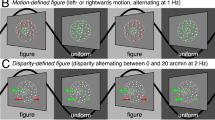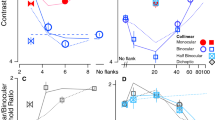Abstract
PATIENTS with scotomas or blind-spots in their visual field1–5 resulting from damage to the visual pathways often report that the pattern from the rest of the visual field 'fills in' to occupy the scotoma. Here we describe a novel technique for generating an artificial perceptual scotoma which enabled us to study the spatial and temporal characteristics of this filling-in process. A homogeneous grey square subtending 1.5° was displayed against a background of twinkling two-dimensional noise of equal mean luminance (Fig. 1). On steady eccentric fixation for 10 s the square vanished and was filled in by the twinkling noise from the surround. Using this display we found that 'filling in' is an active visual process that probably involves creating an actual neural representation of the surround rather than merely ignoring the absence of information from the scotoma; filling in can occur separately for colour and texture, suggesting separate mechanisms; the filling-in process does not completely suppress information from the scotoma, even after an image has faded completely from consciousness it can nevertheless contribute to motion perception; and the process can be strongly influenced by illusory contours.
This is a preview of subscription content, access via your institution
Access options
Subscribe to this journal
Receive 51 print issues and online access
$199.00 per year
only $3.90 per issue
Buy this article
- Purchase on Springer Link
- Instant access to full article PDF
Prices may be subject to local taxes which are calculated during checkout
Similar content being viewed by others
References
Bender, M. B. & Teuber, H. L. Arch. Neur. Psychiat. 55, 627–658 (1946).
Sergent, J. Brain 3, 347–373 (1988).
Weiszcrantz, I. L. in Current Problems in Animal Behavior (eds W. H. Thorpe and O. Zangwill). 30–58 (Cambridge University Press, Cambridge, 1961).
Poppel, E. Nature 320, 523–525 (1986).
Teuber, H. L. in Brain and Conscious Experience (ed. J. C. Eccles) 182–216 (Springer, New York, 1966).
Brewster, D. Letters on natural Magic, addressed to Sir Walter Scott, Bart. (John Murray, London, 1832).
Ramachandran, V. S. & Anstis, S. M. 11th European Conference on Visual Perception. Bristol, UK, 1987.
Ramachandran, V. S. Perception 19, 273 (1990); The Artful Brain (Oxford University Press, in the press).
Zeki, S. M. Nature 335, 311–317 (1988).
Allman, J., Meizin, F. & McGuinnes, E. L. Perception 14, 105–126 (1985).
Van Essen, D. C. A. Rev. Neurosci. 2, 227–263 (1979).
Livingstone, M. S. & Hubel, D. H. J. Neurosci. 7, 3416–3468 (1987).
Krauskopf, J. Am. J. Psychol. 80, 632–637 (1961).
Crane, H. D. & Piantanida, T. P. Science 1078–1079 (1983).
Yarbus, A. L. Eye Movement and Vision (Engl. Trans. Haigh, B; ed. Riggs, L. A.) (Plenum, New York, 1967).
Kaniza, G. Organization in Vision (Prager, New York, 1979).
Gregory, R. L. Nature 238, 51–52 (1972).
Von Der Heydt, R. E., Peterhans, E. & Baumgartner, G. Science 224, 1260–1262 (1978).
Ramachandran, V. S. Perception 14, 127–134 (1985).
Ramachandran, V. S. Soc. Neurosci. Abstr. 15, 624.
Ramachandran, V. S. Perception and Psychophysics 39, 361––373 (1986).
Ramachandran, V. S. Nature 328, 645–647 (1987).
Ramachandran, V. S. in Al and the Eye (eds Blake, A. & Troscianko, T.) 21–77 (Wiley, Bristol, 1990).
Finkel, L. H. & Edelman, G. M. J. Neurosci. 9, 3188–3208 (1989).
Grossberg, S. & Mingolla, E. Psychol. Rev. 92, 173–211 (1985).
Shepard, R. in Perceptual Organization (eds Kubovy, M. & Pomerantz, J. R.) 279–343 (Erlbaum, New Jersey, USA, 1981).
Julesz, B. Foundations of Cyclopean Perception, (University of Chicago Press, Chicago, 1971).
Poggio, T., Torre, V. & Koch, C. Nature 138, 645–647 (1985).
Rock, I. The Logic of Perception (MIT, Cambridge, Massachusetts, 1983).
Troxler, D. in Opthalmologische Bibliothek. II, PT2, 1–53 (1804).
Author information
Authors and Affiliations
Rights and permissions
About this article
Cite this article
Ramachandran, V., Gregory, R. Perceptual filling in of artificially induced scotomas in human vision. Nature 350, 699–702 (1991). https://doi.org/10.1038/350699a0
Received:
Accepted:
Issue Date:
DOI: https://doi.org/10.1038/350699a0
This article is cited by
-
Neural correlates of lateral modulation and perceptual filling-in in center-surround radial sinusoidal gratings: an fMRI study
Scientific Reports (2022)
-
Invisible light inside the natural blind spot alters brightness at a remote location
Scientific Reports (2018)
Comments
By submitting a comment you agree to abide by our Terms and Community Guidelines. If you find something abusive or that does not comply with our terms or guidelines please flag it as inappropriate.



